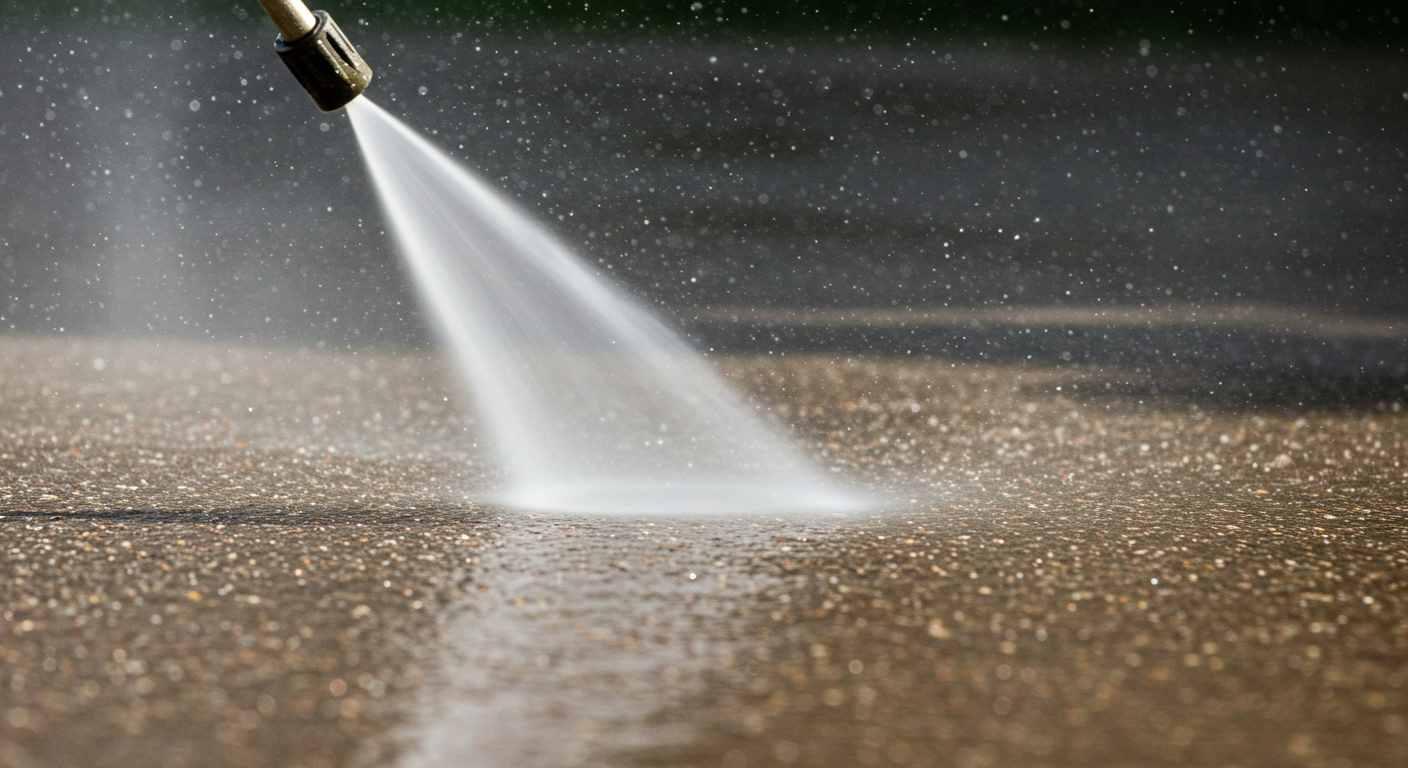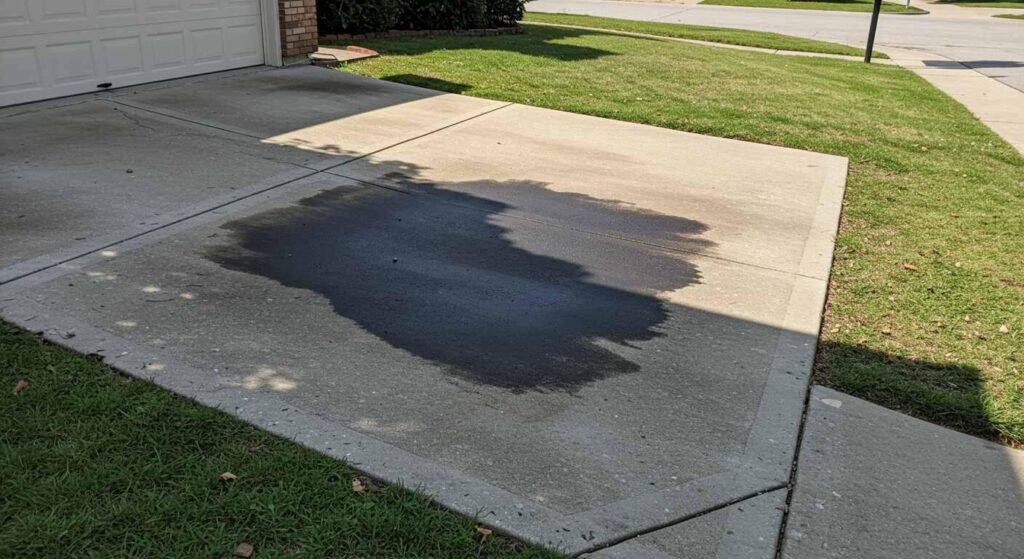It doesn’t take much. A slow leak from the ute, a guest’s dodgy hatchback, or a split bottle during an oil change, and suddenly your driveway’s wearing a stain that won’t budge.
And annoyingly enough, oil doesn’t just sit on top. It seeps in, bakes under the sun, and turns into a greasy reminder every time you pull in. And no, a quick squirt with the hose won’t fix it.
The good news? You’ve got options. Whether it’s fresh and runny or old and crusted in, there’s a right way to clean it without wrecking your surface. This guide walks you through what actually works and when it’s smarter to get a pro in before you turn a stain into a scar.
Fresh Spill? Move Quick Before It Soaks In
If the oil’s still wet, you’re in luck — sort of. That’s your best shot at stopping it before it seeps into every pore of the concrete.
Grab whatever absorbent gear you’ve got: kitty litter, sawdust, even old rags if that’s all you’ve got on hand. Cover the spill thickly, press lightly, and let it sit for 20–30 minutes. Then sweep it up and bin it. Don’t rub. Don’t hose it yet. You’re trying to lift, not spread.
The longer you leave it, the more it’ll soak in, and once it does, you’ll be scrubbing like a madman for half the day.
Light Stains: What Actually Works
Caught the stain a little late? Still manageable.
Start with dish soap and hot water, nothing fancy. Squirt it straight on, scrub with a stiff nylon brush, then rinse. Don’t bother with wire brushes; they chew up your surface and leave marks behind.
If you’re after the DIY route, baking soda and vinegar still do a decent job for fresh-ish stains. Chuck on the bicarb, spray vinegar, let it fizz, then give it a good scrub. Rinse and repeat as needed. No magic, but it’ll shift most of the surface mess.
Pro tip? WD-40 does the job in a pinch, sprays on easily, breaks down the oil, and then you wash it off. Just don’t go soaking the whole driveway in it. You’re cleaning, not detailing a motorbike.
Old Stains: When Elbow Grease Isn’t Enough
Some stains don’t budge. Maybe you missed it. Maybe the sun baked it into the concrete. Either way, soap won’t cut it now.
This is when commercial degreasers step in. Get one made for driveways, none of that general-purpose stuff. Follow the label, give it time to work, and then hit it with a proper scrub. Don’t rush it. These cleaners require a brief soak time to break down the oil effectively.
If the stain’s still giving you grief, pressure washing is an option, but only if the surface can handle it. High pressure on weak or stamped concrete can do more damage than the oil ever did. We’ve pressure cleaned enough Melbourne driveways to know when it helps, and when it’s just blasting your driveway for no reason.
For anything older or cooked in deep? A few rounds may be needed. Clean, dry, reassess, repeat. Better that than permanently living with a greasy welcome mat.
Clean the Driveway You’ve Actually Got, Not the One on YouTube
YouTube might show someone blasting stains off polished concrete with a pressure washer the size of a jet engine, doesn’t mean it’ll work on your surface. Different driveways react differently to oil and cleaners, and using the wrong method can cause more damage than the spill.
Concrete
Common and tough, but still porous. Degreasers, scrubbing, and even controlled pressure washing work well here. Just keep harsh acids off decorative or coloured concrete, or you’ll end up with patchy results.
Asphalt
More delicate. It’s oil-based itself, so avoid anything solvent-heavy or acidic. Use cleaners made specifically for asphalt and keep brushes soft. High heat and pressure? Save that for somewhere else.
Pavers & Stamped Surfaces
Oil loves slipping between joints and edges. Use light, soft brushes and low-pressure rinses, and avoid scrubbing out joint sand. If you have fancy textures or patterns, avoid acidic cleaners, or you’ll strip the look right off.
When You’ve Had Enough – Call Refined Exterior Cleaning
Tried every cleaner under the sun, and that stain’s still hanging on? You’re not alone. Once oil sets deep into concrete or pavers, household products can only go so far. Keep pushing, and you risk damaging the surface more than helping it.
That’s where we come in.
At Refined Exterior Cleaning, we specialise in treating oil stains properly using surface-safe degreasers, precise pressure control, and cleaning methods tailored to your driveway type. No guesswork. No overkill. Just experience-backed results.
We work across Melbourne on concrete, pavers, and decorative finishes, always choosing the right method for the surface. That means no etching, no streaks, and no shortcuts.
If you’re done scrubbing or worried about making it worse, book a clean with us. We’ll sort it out without making it a bigger problem.

No More Guesswork, Just a Clean Driveway
Oil stains happen. Whether from a quick leak or an old one you never saw coming, they don’t have to ruin your concrete. Clean it early, clean it smart, and don’t waste time with methods that only half-work.
And when things get too stubborn or the surface is too sensitive to mess with, we’ve got your back.
Book your professional driveway cleaning with us today. We’ll take care of the mess so you can park without the stress.
Frequently Asked Questions
Will oil stains damage my driveway over time?
Yes, they can. Oil seeps into porous surfaces like concrete and weakens them over time, especially with heat and traffic. If left long enough, it can cause discolouration and surface breakdown that’s hard to reverse.
Can I use engine degreaser from the auto shop on my driveway?
It’s tempting, but not ideal. Most automotive degreasers aren’t designed for porous outdoor surfaces and may leave behind residue or cause staining. Stick to products made for driveways or external concrete.
Is pressure washing always safe for driveways?
Not always. It depends on the surface. Overdoing it can chip, strip, or pit softer materials like exposed aggregate or stamped finishes. That’s why we use pressure-controlled methods specific to your surface type.
How long does it take for a professional clean to fully dry?
Usually 1–2 hours, depending on the weather and surface. We always recommend keeping cars off the area until it’s fully dry to avoid recontamination or marks from tyres.


